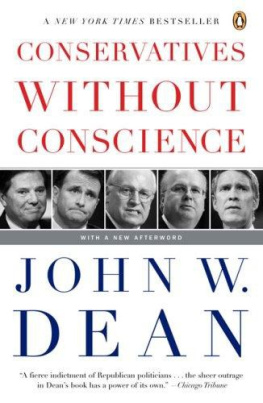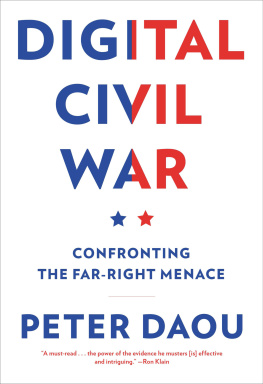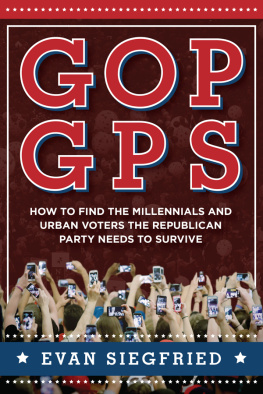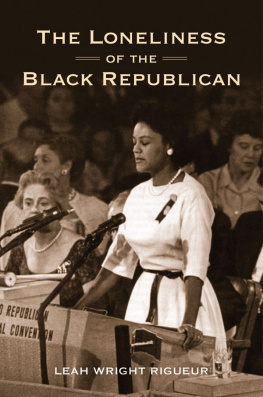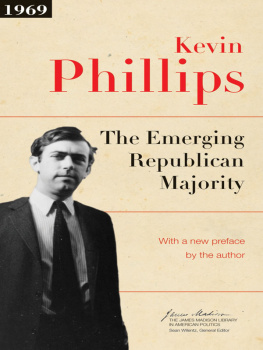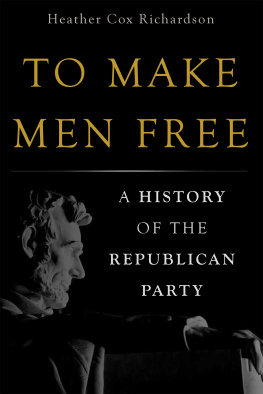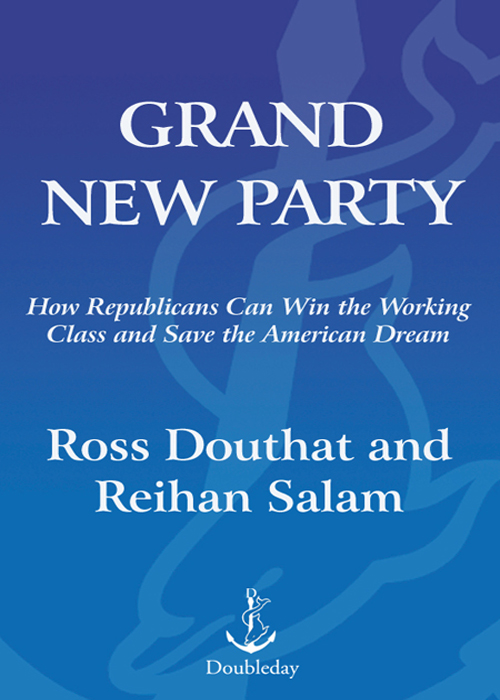
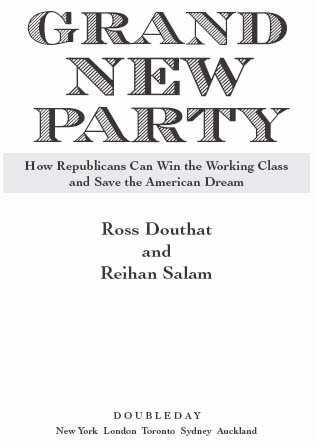
CONTENTS
PART ONE
THE UNFINISHED REALIGNMENT
PART TWO
THE PARTY OF SAMS CLUB
To our parents
INTRODUCTION
A merican politics has awaited a new majority for nearly forty years. The old New Deal coalition began to crack up in 1968, inspiring regular talk about a permanent Republican realignmentin the Nixon era, the Reagan years, the Gingrich moment, and finally in the age of Bush. Yet a substantial majority of the kind that Franklin Roosevelt and Lyndon Baines Johnson enjoyed has persistently eluded the Republican Party. It wasnt until 2000, thirty-two years after Nixon first broke the Democrats hold on power, that the GOP achieved control of the presidency and both branches of Congress, and then only by the barest of margins. Just six years later, a bollixed war and a record of domestic mismanagement cost them both houses, leaving the country more or less where it stood throughout the 1980s and 1990swith a government persistently divided against itself.
This back-and-forth, in which the country tilts right but never quite delivers itself into the hands of the GOP, has frustrated liberals and conservatives alike. On the Right, its produced a palpable sense that what should be their years in majority are being stolen from themwhether by the legacy of Watergate in the 1970s, gerrymandering in the 1980s, or the wiles of Bill Clinton in the 1990s. On the Left, the failure of conservatives to attain LBJ- or FDR-style majorities has bred a persistent delusion that the Democrats can be restored to power with minimal effortby Jimmy Carter in 1976, perhaps, or by Bill Clinton and the New Democrats in 1992, or by the emerging Democratic majority that many left-wing pundits descried on the horizon at the turn of the millennium, only to have the advent of George W. Bush expose it as a mirage.
At the root of both sides disappointment is the refusal of Americas working classthe noncollege-educated voters who make up roughly half of the American electorate, and whose parents and grandparents once formed the heart of the Roosevelt coalitionto pick a side and stick with it. Since 1968, these voters have provided the silent majority that elected Nixon, the Reagan Democrats who gave the Gipper his landslides, and the angry white men who put the Gingrich GOP over the top in 1994. They have transformed the Republican Party from the party of the country club to the party of Sams Club, in Minnesota governor Tim Pawlentys memorable phrase. Yet after each Republican triumph, this working-class constituencythe Sams Club voters, if you willhas become disillusioned with conservative governance and returned to the Democratic column: It happened with Carter, it happened with Clinton, and it happened again in 2006, after just four years of undivided Republican control.
Conservatives and liberals both have their preferred narratives of working-class politics since the 1960s, but neither adequately explains this unfinished realignment. In the Republican story, the working class didnt leave the Democratic Party; the party left themby throwing in its lot with the worst excesses of the New Left, and embracing foreign-policy weakness, destructive cultural permissiveness, and a war on poverty that coddled deadbeats and criminals. At the same time, the demise of socialism demonstrated the moral and economic superiority of capitalism, and working-class voters began to vote their aspirations rather than their fears, rejecting the big-government condescension of American liberalism in favor of the empowerment that accompanies lower taxes and deregulation, weakened unions, and global free trade.
This story helps explain why working-class voters turned to the right from 1968 on, but it doesnt explain why they frequently slide back leftward, because its sunny free-market optimism glosses over the persistent unpopularity of the GOPs small-government message among the Sams Club constituency. There have been moments when a government is the problem argument has resonated with working-class Americans, but for the most part, conservatives have conspicuously failed to earn their trust on most domestic policy questions. Even when noncollege-educated Americans are pulling the lever for the GOP, they consistently give the Democratic Party higher marks on issues ranging from education to health care to Social Security, and two generations of conservative activists, authors, and politicians havent been able to change their minds.
Yet they generally dont vote on these issues alone, and this is where the liberal narrative comes in. Yes, many liberals say, working-class Americans did part ways with the Democrats over issues like affirmative action and crime, national security and sexual permissivenessbut they did so only because the Republicans tricked them into thinking that those issues were more important than the litany of economic concerns that built the Roosevelt majority. Under Nixon, this argument runs, the Right played on white, blue-collar voters basest instincts, convincing them that the Negro in their schools and on their streets was an existential threat that trumped their economic interests. Under Reagan and the elder Bush, it was the same old game, only this time played more subtlyusing code words like welfare queen and Willie Horton to stir up racist feelings that most voters probably didnt even know they had. (I remember looking at these people in the voting line, Bill Clinton recently remarked of the 1980 election, and thinking, Oh my God, its going to be a long night, because they were just glassy-eyed. They were there like somebody had fed them some sort of a controlled substance.)
Lately, as race has receded as a major national issue, the conservative con has supposedly grown more subtle still, relying on a wide array of culture-war controversies to keep the working class securely in its corner. In 2004, Thomas Frank, the most talented of the Lefts cultural critics, limned this supposed deception in Whats the Matter with Kansas?, his opus on working-class backlash. Todays Sams Club voters are, according to Frank, voting on cultural wedge issues like guns and abortion and the rest whose hallucinatory appeal would ordinarily be far overshadowed by material concerns. Conservative policies have immiserated the hardy Kansan laboring classes and fattened up the fat cats, but whereas once the farmers and laborers would have risen up to make the bastards pay, today theyre led rightward by conservative pied pipers, who conjure up a fictive Christmas-banning, gay-marrying liberal conspiracy to absorb the brunt of Middle American outrage.
This sorry state of affairs isnt just the fault of conservative con men and their GOP-voting dupes, Frank insisted; its also the fault of the Democrats, whose cowardice on trade, taxes, unions, and other bread-and-butter questions of economic justice leave these Sams Club voters with nothing else to vote for. The third way triangulation of the Clinton years, with its emphasis on the interests of the upper-middle class, was a criminally stupid strategy that took economic populism off the table and remade the Democrats as the other pro-business party. With no one looking out for their economic interests, the poor buffeted plainsfolk of Kansas are pushed into the hands of a cynical GOP, which stokes culture-war outrage but never follows through: Abortion is never halted. Affirmative action is never abolished. The culture industry is never forced to clean up its act.
Next page

